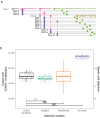Quantitatively assessing early detection strategies for mitigating COVID-19 and future pandemics
- PMID: 38123536
- PMCID: PMC10733317
- DOI: 10.1038/s41467-023-44199-7
Quantitatively assessing early detection strategies for mitigating COVID-19 and future pandemics
Abstract
Researchers and policymakers have proposed systems to detect novel pathogens earlier than existing surveillance systems by monitoring samples from hospital patients, wastewater, and air travel, in order to mitigate future pandemics. How much benefit would such systems offer? We developed, empirically validated, and mathematically characterized a quantitative model that simulates disease spread and detection time for any given disease and detection system. We find that hospital monitoring could have detected COVID-19 in Wuhan 0.4 weeks earlier than it was actually discovered, at 2,300 cases (standard error: 76 cases) compared to 3,400 (standard error: 161 cases). Wastewater monitoring would not have accelerated COVID-19 detection in Wuhan, but provides benefit in smaller catchments and for asymptomatic or long-incubation diseases like polio or HIV/AIDS. Air travel monitoring does not accelerate outbreak detection in most scenarios we evaluated. In sum, early detection systems can substantially mitigate some future pandemics, but would not have changed the course of COVID-19.
© 2023. The Author(s).
Conflict of interest statement
W.P.H. is a member of the scientific advisory board and has stock options in BioBot Analytics. M.S. is a cofounder of Rhinostics and consults for the diagnostic consulting company Vectis Solutions LLC. The other authors declare that they have no competing interests.
Figures



Update of
-
Quantitatively assessing early detection strategies for mitigating COVID-19 and future pandemics.medRxiv [Preprint]. 2023 Oct 6:2023.06.08.23291050. doi: 10.1101/2023.06.08.23291050. medRxiv. 2023. Update in: Nat Commun. 2023 Dec 20;14(1):8479. doi: 10.1038/s41467-023-44199-7. PMID: 37398047 Free PMC article. Updated. Preprint.
References
-
- Ferguson, N. M. et al. Report 9 - Impact of non-pharmaceutical interventions (NPIs) to reduce COVID-19 mortality and healthcare demand. https://www.imperial.ac.uk/medicine/departments/school-public-health/inf... (2020). - PMC - PubMed
Publication types
MeSH terms
Substances
Grants and funding
LinkOut - more resources
Full Text Sources
Medical

